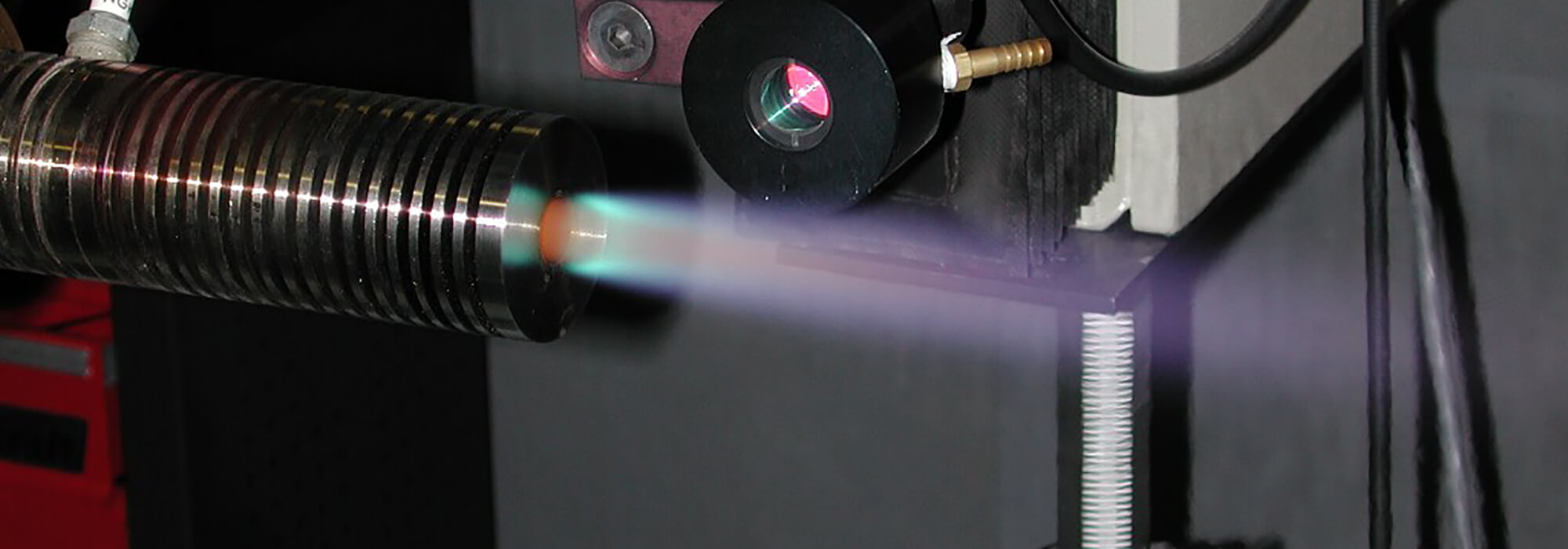Droplet Laboratory
Dropsizer
The DropSizer consists of a camera and a Class IIIb laser with a wavelength of 905 nm pulsing at 100 ns. The camera captures images at 15 frames per second, and with a resolution of 2560 x 1920 pixels. The depth of field is 0.23 mm, and the field of view is 3.20 x 2.40 mm. The droplet size distribution of a spray can be characterized using the DropSizer.

High Velocity Droplet Impact Experiments
To achieve high impact velocities, it is easier to accelerate the substrate rather than the droplet. One way of doing this is to mount the substrate on the end of a rotating arm. The schematic diagram shows the apparatus we built to capture images of droplet impact by synchronizing the ejection of a droplet from the generator with the position of the moving substrate.
The test surfaces on which droplets impinged were stainless steel coupons mounted on an aluminum plate bolted to the outer rim of a 400 mm diameter aluminum flywheel. A vertical rod inserted through the hub of the flywheel was connected to the shaft of a servo motor that could reach rotational speeds of up to 3500 rpm, giving the test surface linear velocities of up to 80 m/s.

Schematic diagram of apparatus to photograph high velocity droplet impact
Droplet generation
Many engineering applications require the production of small, uniform sized droplets. Droplet generators were first developed as research tools to investigate droplet dynamics, spray cooling and droplet combustion, or to calibrate particle size measuring instruments. They have since found use in many industrial applications such as ink-jet printing, dispensing controlled volumes of pharmaceuticals, and deposition of adhesive or solder droplets on circuit boards. In recent years there has been great interest in droplet based manufacturing techniques for rapid prototype production. Development of all these technologies requires a reliable method of generating droplets on demand. CACT has developed a pneumatic droplet-on-demand generator which works by applying pulses of pressurised gas to liquid contained in a chamber, forcing out droplets through a nozzle in the bottom plate of the generator. A solenoid valve is rapidly opened and closed to create pressure pulses. There are no moving parts in contact with the liquid, making the generator simple to build, sturdy, and easy to adapt to high temperature applications.

Schematic diagram of molten metal droplet generator
Rapid Prototyping by Droplet Deposition
Rapid prototyping by deposition of droplets is an additive process in which components are manufactured from molten materials in a single operation without the use of a mold or other tooling. Near net shape parts are fabricated by sequentially depositing molten droplets layer by layer. Droplet based manufacturing techniques have been successfully used to make components out of wax, polymers, and ice, which are useful for prototyping or to make patterns for castings. Various commercial versions of this technology, popularly known as 3-D printers, have been available for several years.
A logical next step in rapid prototyping technology would be to make functional metal parts by droplet deposition. However, this has proved to be far more complex than simply adapting existing 3-D printers to produce molten metal droplets. Metals of commercial importance have much higher values of surface tension, melting temperature, latent heat of solidification and thermal conductivity than waxes or polymers, making it much more difficult to make droplets fuse together to form a smooth surface after solidification. CACT has developed techniques to make three-dimensional metal parts by droplet deposition. A pneumatic droplet generator is used to produce droplets, which are deposited on a substrate mounted on a programmable stage. By manipulating the substrate complex shapes can be built up.



Three-dimensional objects fabricated by depositing 0.18 mm diameter tin droplets

